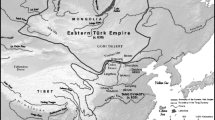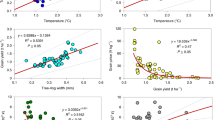Abstract
The 1815 eruption of the Tambora volcano led to the “Year without a Summer” and caused serious crop failure and famines in 1816 across Europe and North America. However, few reports are available on Tambora’s influence in China despite the region’s susceptibility to monsoonal volcanic perturbation. This study presents a systemic analysis of the climatic and related social responses to the Tambora perturbation in China, by using two independent lines of proxy records and projecting the responses on top of the impacts averaged over all tropical eruptions of the past millennium. Both the tree ring and Chinese documentary proxies show that Tambora induced a cold excursion, which caused severe frost damage, snow and ice accumulations that are uncommonly seen in southern China. Cold temperature tends to cause drought by suppressing evaporation and monsoonal circulation—a hydroclimate response that is evident in the tree-ring-based Monsoon Asia Drought Atlas but largely missing in a multiproxy precipitation reconstruction. Historical records of drought, flood, frost, and famine also show fairly mild responses outside southern China, which may be partially due to the insensitivity of documentary records to the Tambora-induced perturbation, or the cold background climate set up by the low solar insolation of the coincident Dalton Minimum and a preceding unknown eruption in 1809. The results presented here provide new insights into the spatial extent and characteristics of the Tambora perturbation, by providing a systematic evaluation of the climatic aftermath in China in parallel to that in Europe and North America. They also argue for the integral use of multiple proxies from different regions of the world to gain a better understanding of the climatic impacts for individual volcanic eruptions.
Similar content being viewed by others
References
Adams, J. B., M. E. Mann, and C. M. Ammann, 2003: Proxy evidence for an El Niño-like response to volcanic forcing. Nature, 426, 274–278, doi: 10.1038/nature02101.
Brönnimann, S., M. Grosjean, F. Joos, et al., 2015: Lessons from Tambora. PAGES Newsletter, 23, 69, doi: 10.22498/pages.
Cook, E. R., K. J. Anchukaitis, B. M. Buckley, et al., 2010: Asian monsoon failure and megadrought during the last millennium. Science, 328, 486–489, doi: 10.1126/science.1185188.
Cook, E. R., P. J. Krusic, K. J. Anchukaitis, et al., 2013: Tree-ring reconstructed summer temperature anomalies for temperate East Asia since 800 C.E. Climate Dyn., 41, 2957–2972, doi: 10.1007/s00382-012-1611-x.
Dai, A. G., K. E. Trenberth, and T. T. Qian, 2004: A global dataset of Palmer Drought Severity Index for 1870–2002: Relationship with soil moisture and effects of surface warming. J. Hydrometeor., 5, 1117–1130, doi: 10.1175/JHM-386.1.
Fei, J., and J. Zhou, 2015: The drought and locust plague of 942–944 AD in the Yellow River basin, China. Quat. Int., 394, 115–122, doi: 10.1016/j.quaint.2014.11.053.
Fei, J., J. Zhou, and Y. J. Hou, 2007: Circa A. D. 626 volcanic eruption, climatic cooling, and the collapse of the Eastern Turkic Empire. Clim. Change, 81, 469–475, doi: 10.1007/ s10584-006-9199-y.
Feng, S., Q. Hu, Q. R. Wu, et al., 2013: A gridded reconstruction of warm season precipitation for Asia spanning the past half millennium. J. Climate, 26, 2192–2204, doi: 10.1175/JCLID-12-00099.1.
Harington, C. R., 1992: The Year Without a Summer?—World Climate in 1816. Canadian Museum of Nature, Ottawa, 576 pp.
Haywood, J., A. Jones, N. Bellouin, et al., 2013: Asymmetric forcing from stratospheric aerosols impacts Sahelian rainfall. Nat. Climate Change, 3, 660–66 5, doi: 10.1038/nclimate1857.
Iles, C. E., and G. C. Hegerl, 2014: The global precipitation response to volcanic eruptions in the CMIP5 models. Environ. Res. Lett., 9, 104012, doi: 10.1088/1748-9326/9/10/104012.
Kandlbauer, J., P. O. Hopcroft, P. J. Valdes, et al., 2013: Climate and carbon cycle response to the 1815 Tambora volcanic eruption. J. Geophys. Res., 118, 12497–12507.
Legates, D. R., and C. J. Willmott, 1990: Mean seasonal and spatial variability in gauge-corrected global precipitation. Int. J. Climatol., 10, 111–127, doi: 10.1002/(ISSN)1097-0088.
Li, Y. S., 2009: The relationship between the harvest of Clupea pallasi and the abrupt climate change after 1816. Academics in China, 138, 42–55.
Luterbacher, J., and C. Pfister, 2015: The year without a summer. Nat. Geosci., 8, 246–248, doi: 10.1038/ngeo2404.
Man, W. M., T. J. Zhou, and J. H. Jungclaus, 2014: Effects of large volcanic eruptions on global summer climate and East Asian monsoon changes during the last millennium: Analysis of MPI-ESM simulations. J. Climate, 27, 7394–7409, doi: 10.1175/JCLI-D-13-00739.1.
McKee, T. B., N. J. Doesken, and J. Kleist, 1993: The relationship of drought frequency and duration to timescales. Paper Presented at 8th Conference on Applied Climatology, Anaheim, CA, Amer. Meteor. Soc.
Oppenheimer, C., 2003: Climatic, environmental and human consequences of the largest known historic eruption: Tambora volcano (Indonesia) 1815. Prog. Phys. Geogr., 27, 230–259, doi: 10.1191/0309133303pp379ra.
Oppenheimer, C., 2015: Eruption politics. Nat. Geosci., 8, 244–245, doi: 10.1038/ngeo2408.
PAGES 2K Consortium, 2013: Continental-scale temperature variability during the past two millennia. Nat. Geosci., 6, 339–346, doi: 10.1038/ngeo1797.
Peng, Y. B., C. M. Shen, W. C. Wang, et al., 2010: Response of summer precipitation over eastern China to large volcanic eruptions. J. Climate, 23, 818–824, doi: 10.1175/2009JCLI2950.1.
Raible, C. C., S. Brönnimann, R. Auchmann, et al., 2016: Tambora 1815 as a test case for high impact volcanic eruptions: Earth system effects. WIRs: Climate Change, 7, 569–589, doi: 10.1002/wcc.2016.7.issue-4.
Robock, A., 2001: Volcanic eruption, Tambora. Encyclopedia of Global Environmental Change. T. Munn, Ed., John Wiley and Sons, London, 1, 737–738.
Schmidt, A., and A. Robock, 2015: Volcanism, the atmosphere, and climate through time. Volcanism and Global Environmental Change. A. Schmidt., E. Fristad, and L. T. Elkins-Tanton, Eds., Cambridge University Press, Cambridge, UK, 195–207.
Self, S., R. Gertisser, T. Thordarson, et al., 2004: Magma volume, volatile emissions, and stratospheric aerosols from the 1815 eruption of Tambora. Geophys. Res. Lett., 31, L20608, doi: 10.1029/2004GL020925.
Shi, C., V. Daux, Q. B. Zhang, et al., 2012: Reconstruction of southeast Tibetan Plateau summer climate using tree ring δ18O: Moisture variability over the past two centuries. Climate Past, 8, 205–213, doi: 10.5194/cp-8-205-2012.
Sigl, M., M. Winstrup, J. R. McConnell, et al., 2015: Timing and climate forcing of volcanic eruptions for the past 2500 years. Nature, 523, 543–549, doi: 10.1038/nature14565.
Stothers, R. B., 1984: The great Tambora eruption in 1815 and its aftermath. Science, 224, 1191–1198, doi: 10.1126/science. 224.4654.1191.
Wegmann, M., S. Brönnimann, J. Bhend, et al., 2014: Volcanic influence on European summer precipitation through monsoons: Possible cause for “Years without Summer”. J. Climate, 27, 3683–3691, doi: 10.1175/JCLI-D-13-00524.1.
Yang, Y. D., Z. M. Man, and J. Y. Zheng, 2005: A serious famine in Yunnan (1815–1817) and the eruption of Tambola volcano. Fudan J. (Soc. Sci. Chin.), 1, 79–85.
Zhang, D. E., 2004: A Compendium of Chinese Meteorological Records of the Last 3000 Years. Jiangsu Education Press House, Nanjing, 2701–2843. (in Chinese)
Zhuo, Z. H., C. C. Gao, and Y. Q. Pan, 2014: Proxy evidence for China’s monsoon precipitation response to volcanic aerosols over the past seven centuries. J. Geophys. Res., 119, 6638–6652.
Author information
Authors and Affiliations
Corresponding author
Additional information
Supported by the National Natural Science Foundation of China (41501066) and National (Key) Basic Research and Development (973) Program of China (2015CB953601).
Rights and permissions
About this article
Cite this article
Gao, C., Gao, Y., Zhang, Q. et al. Climatic aftermath of the 1815 Tambora eruption in China. J Meteorol Res 31, 28–38 (2017). https://doi.org/10.1007/s13351-017-6091-9
Received:
Accepted:
Published:
Issue Date:
DOI: https://doi.org/10.1007/s13351-017-6091-9




